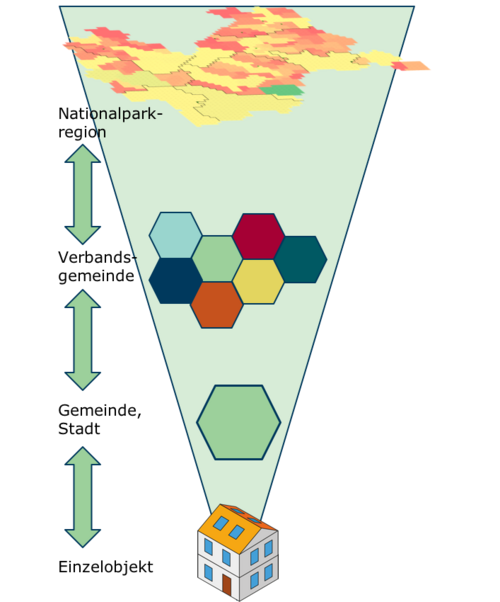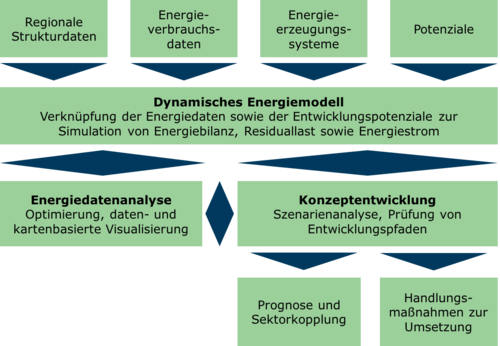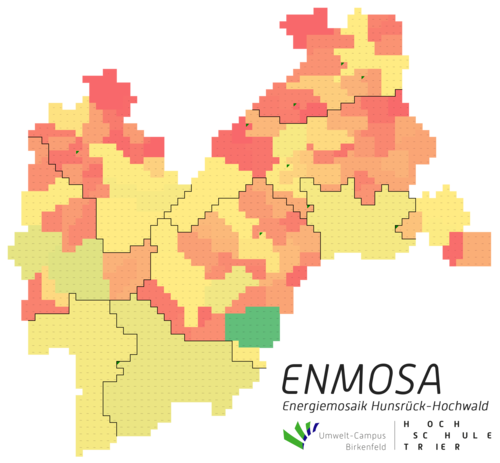
The project ENMOSA - Energy Mosaic Hunsrück-Hochwald - will develop and provide a dynamic tool for the analysis and prognosis of the energetic use of the sectors electric power, heat and transport for the national park region Hunsrück-Hochwald. The aim is to develop a model based on the energy consumption data and energy production systems from which key indicators can be derived to ensure that the national park region achieves decarbonisation of the energy supply in the long term and thus reduces greenhouse gas emissions.
The aggregation of all energy-relevant data creates transparency in energy data management in the region. The modular structure of the simulation model of the region allows flexible change of the display and analysis levels from the entire national park region to the individual object (see figure on the right). Normalisation of the simulation model ensures expandability and creates interfaces for linking with other projects. Continuous testing of measures and forecasts in the simulator enables the identification of potentials and risks. Finally, the integration of all participants leads to a sustainable further development of the region.

The figure on the left shows the project structure of the ENMOSA project. The regional structural data (cadastral information, infrastructure, statistical data), energy consumption data for the electricity, heat and transport sectors, data on energy generation systems and potential areas (e.g. roof areas for the expansion of photovoltaics or solar thermal energy) are compiled and stored in a relational database. The dynamic energy model accesses these data in order to link the energy data and the development potentials in the simulation core, so that the energy balance, the residual loads and the energy flow can be calculated. The energy model is followed by the energy data analysis in order to evaluate and optimize the energy data on the one hand and to visualize the evaluated data on the other hand. The results of the data analysis are fed back into the energy model. The concept development combines the data from the energy model and the analysis in order to examine different scenarios and development paths. Effects from the scenario analysis flow back into the energy model for iterative optimization of the simulator. This allows the development of forecasts for sector coupling and the derivation of action measures.
![[Translate to Englisch:] ENMOSA - Energiemodell [Translate to Englisch:] ENMOSA - Energiemodell](/fileadmin/_processed_/d/a/csm_ENMOSA_Grundkonzept_982dc9b6fe.png)
The basic concept for the dynamic simulation of the units in the energy model is shown in the following figure. The energy model first includes information on the energy use of households, commercial and industry. Furthermore, the generation profiles of the energy generation units, in particular wind, photovoltaics and biomass, are integrated. Finally, usage profiles of the transport sector are taken into account. The model is supplemented by grid capacities in the electricity and heat sectors. Optionally, different types of storage (electricity, heat, Power-to-X) can be integrated into the model. In the simulator, the profiles, the generation systems and the consumption units can be parameterised so that a comprehensive scenario analysis is possible.
Based on the presented project structure and the basic concept of the simulation, the objectives of the ENMOSA project can be differentiated into primary and secondary objectives.
Raising awareness of sustainable energy policy development in the Hunsrück-Hochwald National Park region,
Linking the results with third-party projects (e.g. Designetz, EnergiewabenGR),
Transfer and extension of the model to other regions.
The benefits of the project results can be classified according to the individual groups:

The ENMOSA project is constantly looking for students who can make a significant contribution to the project within the framework of specialist projects, interdisciplinary project work and bachelor's or master's theses.
Current tasks in the project:
If you are interested in joining the project, please send a mail to Prof. te Heesen.
You are leaving the official website of Trier University of Applied Sciences